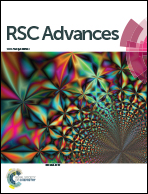A sensitive and selective BINOL based ratiometric fluorescence sensor for the detection of cyanide ions†
Abstract
A highly selective, novel BINOL based sensor BBCN has been developed for the fluorescent ratiometric detection of cyanide ions (CN−). The optical study revealed that BBCN exhibited unique spectral changes only with cyanide ions in the presence of other competing ions. Besides, an apparent fluorescent colour change from green to blue was observed. A clear linear relationship was observed between the fluorescence ratiometric ratio of BBCN and the concentration of CN− with a reasonably low detection limit (LOD) of 189 nM (507 ppb). The optical response was due to the nucleophilic addition of CN− to the dicyanovinyl group of the sensor, which compromises the probe's intramolecular charge transfer. This mechanism was well confirmed by Job's plot, 1H-NMR and ESI-MS studies. BBCN showed immediate spectral response towards (1 second) CN− and detection could be realized in a broad pH window. Furthermore, the practical utility of BBCN was studied by test paper-based analysis and the detection of CN− in various water resources.



 Please wait while we load your content...
Please wait while we load your content...